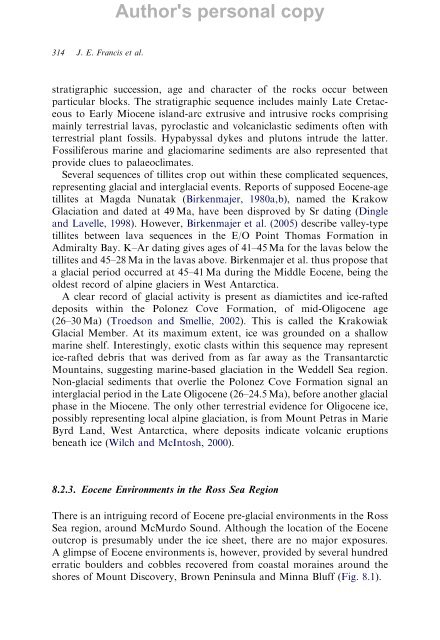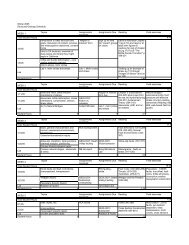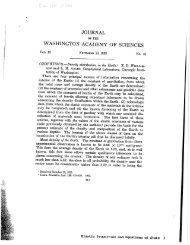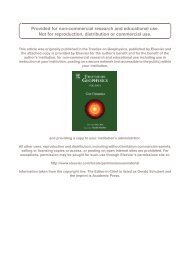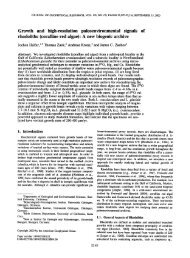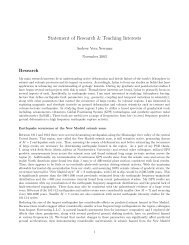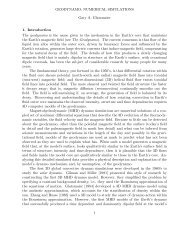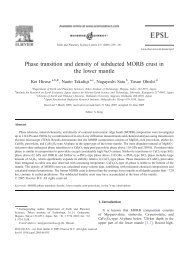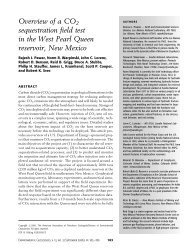From Greenhouse to Icehouse – The Eocene/Oligocene - UMass ...
From Greenhouse to Icehouse – The Eocene/Oligocene - UMass ...
From Greenhouse to Icehouse – The Eocene/Oligocene - UMass ...
You also want an ePaper? Increase the reach of your titles
YUMPU automatically turns print PDFs into web optimized ePapers that Google loves.
314 J. E. Francis et al.<br />
Author's personal copy<br />
stratigraphic succession, age and character of the rocks occur between<br />
particular blocks. <strong>The</strong> stratigraphic sequence includes mainly Late Cretaceous<br />
<strong>to</strong> Early Miocene island-arc extrusive and intrusive rocks comprising<br />
mainly terrestrial lavas, pyroclastic and volcaniclastic sediments often with<br />
terrestrial plant fossils. Hypabyssal dykes and plu<strong>to</strong>ns intrude the latter.<br />
Fossiliferous marine and glaciomarine sediments are also represented that<br />
provide clues <strong>to</strong> palaeoclimates.<br />
Several sequences of tillites crop out within these complicated sequences,<br />
representing glacial and interglacial events. Reports of supposed <strong>Eocene</strong>-age<br />
tillites at Magda Nunatak (Birkenmajer, 1980a,b), named the Krakow<br />
Glaciation and dated at 49 Ma, have been disproved by Sr dating (Dingle<br />
and Lavelle, 1998). However, Birkenmajer et al. (2005) describe valley-type<br />
tillites between lava sequences in the E/O Point Thomas Formation in<br />
Admiralty Bay. K<strong>–</strong>Ar dating gives ages of 41<strong>–</strong>45 Ma for the lavas below the<br />
tillites and 45<strong>–</strong>28 Ma in the lavas above. Birkenmajer et al. thus propose that<br />
a glacial period occurred at 45<strong>–</strong>41 Ma during the Middle <strong>Eocene</strong>, being the<br />
oldest record of alpine glaciers in West Antarctica.<br />
A clear record of glacial activity is present as diamictites and ice-rafted<br />
deposits within the Polonez Cove Formation, of mid-<strong>Oligocene</strong> age<br />
(26<strong>–</strong>30 Ma) (Troedson and Smellie, 2002). This is called the Krakowiak<br />
Glacial Member. At its maximum extent, ice was grounded on a shallow<br />
marine shelf. Interestingly, exotic clasts within this sequence may represent<br />
ice-rafted debris that was derived from as far away as the Transantarctic<br />
Mountains, suggesting marine-based glaciation in the Weddell Sea region.<br />
Non-glacial sediments that overlie the Polonez Cove Formation signal an<br />
interglacial period in the Late <strong>Oligocene</strong> (26<strong>–</strong>24.5 Ma), before another glacial<br />
phase in the Miocene. <strong>The</strong> only other terrestrial evidence for <strong>Oligocene</strong> ice,<br />
possibly representing local alpine glaciation, is from Mount Petras in Marie<br />
Byrd Land, West Antarctica, where deposits indicate volcanic eruptions<br />
beneath ice (Wilch and McIn<strong>to</strong>sh, 2000).<br />
8.2.3. <strong>Eocene</strong> Environments in the Ross Sea Region<br />
<strong>The</strong>re is an intriguing record of <strong>Eocene</strong> pre-glacial environments in the Ross<br />
Sea region, around McMurdo Sound. Although the location of the <strong>Eocene</strong><br />
outcrop is presumably under the ice sheet, there are no major exposures.<br />
A glimpse of <strong>Eocene</strong> environments is, however, provided by several hundred<br />
erratic boulders and cobbles recovered from coastal moraines around the<br />
shores of Mount Discovery, Brown Peninsula and Minna Bluff (Fig. 8.1).


